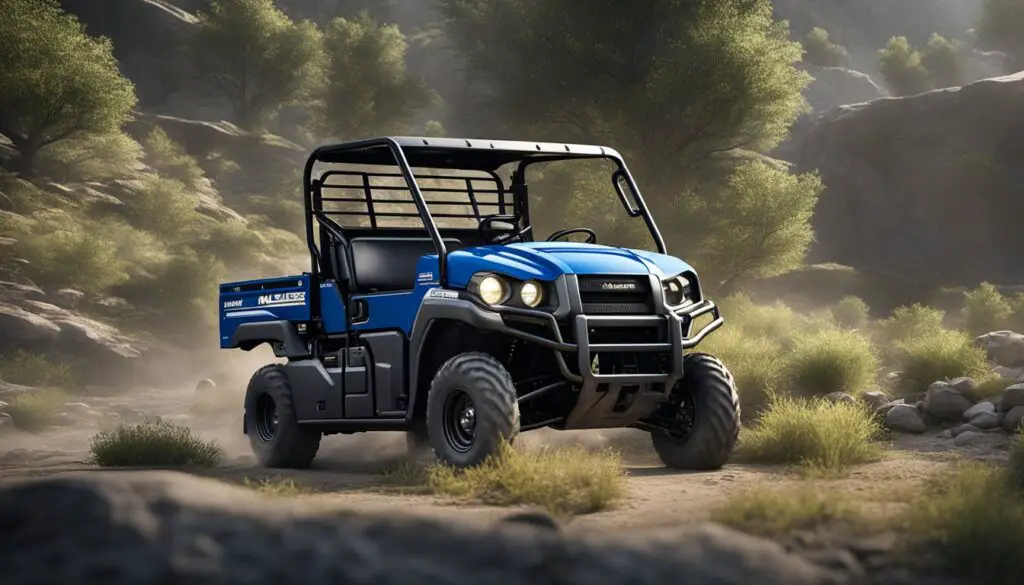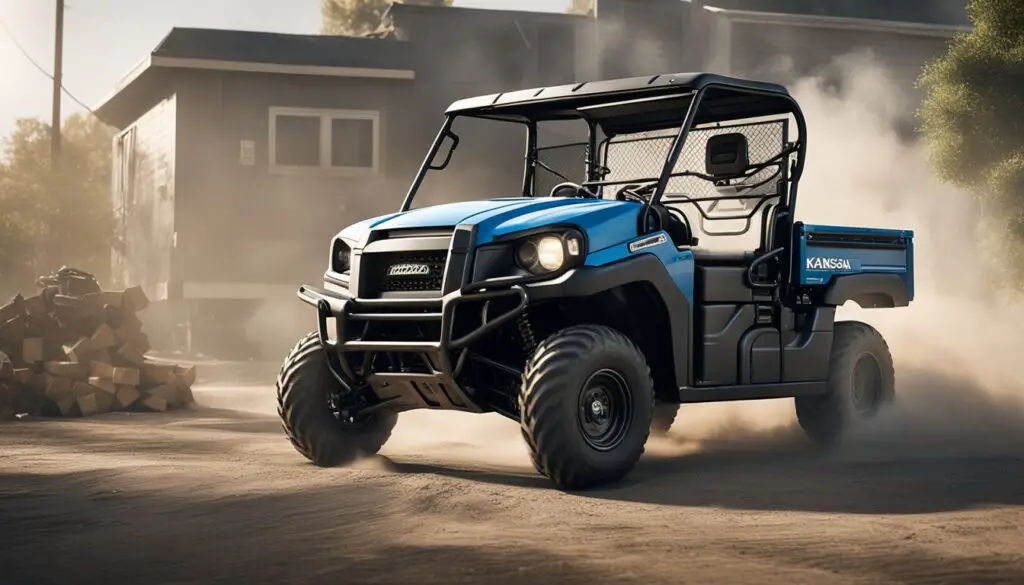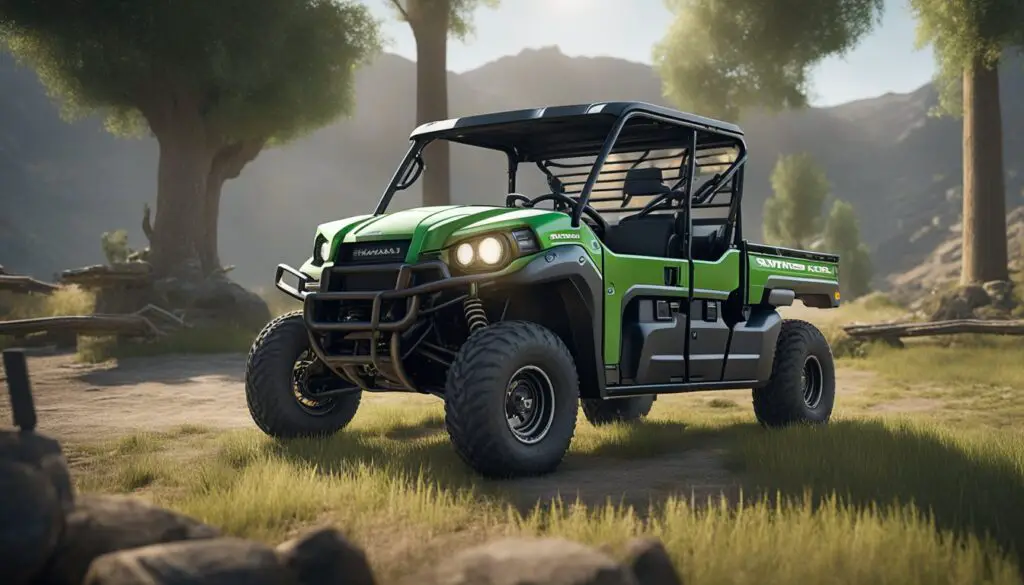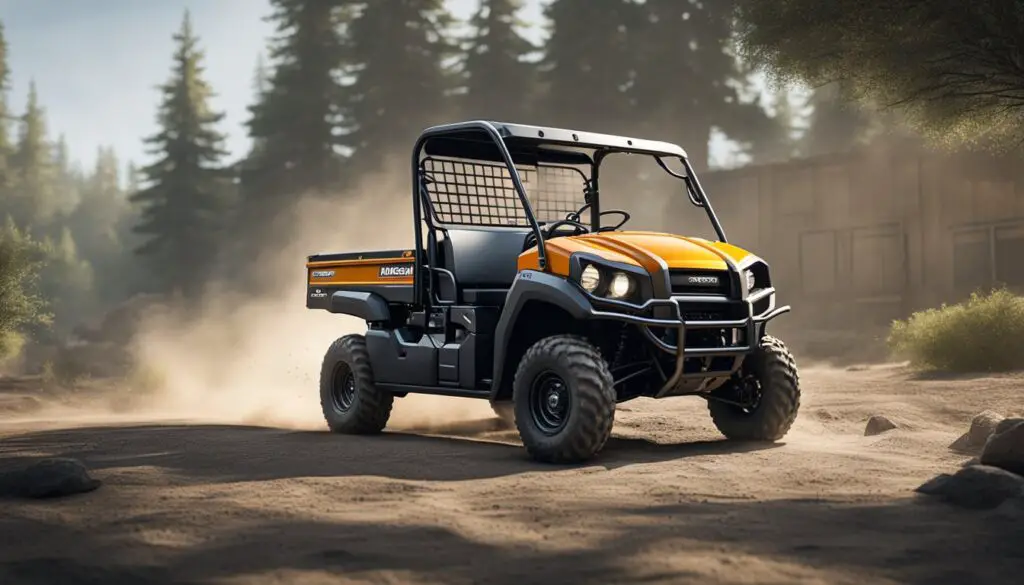Owning a Kawasaki Mule UTV comes with the assurance of reliability and solid performance, but like all mechanical vehicles, it is not immune to issues. Among the most common concerns that you might encounter is trouble with the fuel pump, a critical component for the Mule’s operation. The fuel pump is responsible for delivering fuel from the tank to the engine, making its proper functioning essential for the Mule’s performance.

Fuel pump problems in a Kawasaki Mule can manifest in various ways, such as the engine stalling or not starting at all. These issues can stem from electrical system complications, clogged fuel filters, or even the fuel tank vent being blocked. Regular maintenance is key to prolonging the life of your Mule and ensuring it performs to its full potential. Being proactive in addressing these fuel pump issues can save you from unexpected downtimes and the inconvenience of a vehicle that won’t start or suddenly stops running.
Key Takeaways
- Fuel pump issues are among the common problems experienced with Kawasaki Mules.
- Proper maintenance can prevent most fuel system disruptions.
- Quick attention to fuel pump symptoms ensures the reliability of your UTV.
Recognizing Common Kawasaki Mule Fuel Pump Problems
When you’re dealing with Kawasaki Mule fuel pump problems, it’s crucial to recognize the signs to avoid getting stranded. Fuel pump issues can manifest in a variety of ways, but there are consistent symptoms to keep an eye out for:
- Engine Stalling: A bad fuel pump may lead to unexpected stalling, usually due to insufficient fuel delivery to the engine.
- Starting Difficulty: If you’re cranking your Mule for longer than usual or it refuses to start, your fuel pump might not be priming properly.
- Inconsistent Performance: Your Mule could experience loss of power or sputter during operation, often indicative of fuel pump dilemmas.
For the troubleshooting enthusiast, here’s a bullet list to navigate through common problems:
- Check the Fuel Filter: Clogs can starve the engine of fuel, reminiscent of pump failure.
- Examine the Tank Vent: A blocked vent will affect pressure and can simulate pump issues.
- Inspect the Wiring: Faulty connections can also mimic a failing pump.
- Listen for Operation: A silent pump at key-on could indicate it’s time for replacement.
Remember, frequent causes of fuel pump troubles include debris, sediment build-up, and corrosion—often exacerbated by ethanol-blended fuels.
In your quest to fix fuel pump problems, assess these areas calmly and systematically. Should these initial steps not resolve the issue, consider fuel pump replacement as a necessary course of action. Your Mule depends on a healthy fuel delivery system, and so does your peace of mind when out on the trails or working on your property.
Basic Troubleshooting Steps
When you’re dealing with fuel pump problems on your Kawasaki Mule, it’s essential to approach the issue methodically. Here’s how you can start troubleshooting using basic tools and a bit of patience.
Initial Checks:
- Visual Inspection:
- Check for any obvious signs of damage or leaks.
- Look for debris that might be clogging up the system.
- Spark Plugs:
- Inspect your spark plugs for wear or fouling.
- Clean or replace them if necessary.
Battery State:
- Ensure that your battery is fully charged and in good condition. The fuel pump requires adequate electric power to function effectively.
Fuel System Inspection:
- Check the fuel filter and make sure it’s free from clogs.
- Inspect the fuel tank vent for any blockages that could prevent proper fuel flow.
Heat and Moisture:
- Consider if heat or moisture exposure could be affecting the fuel pump performance, especially if the issues occur after extended use or in damp conditions.
Service Manual Consultation:
- A downloadable service manual for your specific Mule model is an invaluable resource. It can offer detailed steps for troubleshooting.
- Service manuals often include diagrams and specifications for your vehicle, which can assist you significantly.
Required Tools:
- Make sure you have basic hand tools appropriate for your Kawasaki Mule. These might include screwdrivers, pliers, and a multimeter for electric tests.
Remember, always work in a well-ventilated area and take care when working with the fuel system to prevent spills or fires. If these steps don’t solve the issue, consider seeking assistance from a professional mechanic. Your safety and the proper functioning of your Mule are paramount.
Engine and Ignition Related Problems

Your Kawasaki Mule’s performance hinges significantly on the health of its engine and ignition system. Recognizing and addressing issues like overheating or ignition faults are crucial for maintaining efficient operation and preventing unexpected breakdowns.
Engine Overheating and Performance
If your Mule engine is overheating, the root cause may be a clogged fuel filter restricting clean fuel flow, or a malfunctioning fuel pump which fails to supply the right amount of fuel, leading to an engine sputtering or a reduced power scenario. It’s essential to ensure the fuel system is clear of carbon deposits and debris. Regular checks and maintenance can prevent engine problems and keep performance at peak levels.
- Checklist to Avoid Overheating:
- Ensure the fuel filter is clean.
- Verify the fuel pump is functioning properly.
- Inspect for any carbon deposits and clean accordingly.
Ignition Coil and Switch Issues
The ignition system is composed of spark plugs, an ignition coil, and the ignition switch, all of which work in harmony to start your engine and keep it running smoothly. A faulty ignition coil or a problematic ignition switch can cause your engine to lose power or may even prevent it from starting.
- Ignition System Maintenance Tips:
- Spark Plugs: Check and replace if worn out or covered in deposits.
- Ignition Coil: Test the coil to ensure it’s providing sufficient voltage.
- Ignition Switch: Clean the contacts and check for any signs of wear or damage.
By taking a hands-on approach to troubleshooting and routine checks, you can head off many common engine and ignition related issues. Remember, a little preventive care will go a long way in keeping your Kawasaki Mule running reliably.
Electrical System Complications

When dealing with a Kawasaki Mule, electrical issues can often manifest through the fuel pump system, leading to starting problems. It’s crucial for you to check the battery, cable connections, and the Electronic Control Unit (ECU), as these components are often the root of the issue.
Battery and Cable Connections
Your Kawasaki Mule’s ability to start reliably hinges on a healthy battery and secure cable connections. A dead battery is a common culprit for starting problems. Ensure that your battery is fully charged and holding a charge properly. Loose battery cables, especially the negative battery cable, can also cause electrical issue. Regularly inspect and tighten the battery terminals to maintain a solid electrical connection.
- Checklist for Battery Health:
- Charge levels: Ensure the battery is fully charged.
- Cable connections: Verify that all connections are secure.
- Battery age: Consider replacement if the battery is old and no longer reliable.
Electronic Control Unit (ECU) and Sensors
The ECU is the brain of your Kawasaki Mule, coordinating the engine’s functions, including the fuel pump operation. Sensor failures or a malfunctioning ECU can lead to erratic or non-existent fuel pump performance. You should monitor the ECU for error codes and ensure all sensors related to the fuel system are functioning correctly.
- Sensor Monitoring:
- Fuel pressure sensor: Checks fuel delivery pressure.
- Temperature sensor: Monitors engine temperature.
Relays and Electrical Components
Relays are essential for directing power in the electrical system, and a faulty relay can interrupt power to the fuel pump. Locate your Mule’s fuel pump relay and test it with a multimeter for proper functioning. Other electrical components, such as fuses and wiring, should be inspected for damage or signs of wear that could lead to electrical issues.
- Relay Inspections:
- Fuel pump relay: Test for continuity and replace if faulty.
- Fuse check: Ensure no blown fuses are affecting the fuel system.
By keeping a close watch on these electrical system components, you can often prevent or quickly resolve issues that may otherwise hinder the performance of your Kawasaki Mule’s fuel pump.
Fuel System Maintenance

Proper upkeep of your Kawasaki Mule’s fuel system is crucial for ensuring a smooth ride and preventing unwanted hiccups during operation. Regular checking and cleaning of vital components will help you avoid common fuel pump issues and maintain optimal fuel pressure.
Fuel Filter and Fuel Line Inspection
Your fuel filter plays a vital role in keeping the fuel in your Kawasaki Mule clean and free from debris. Clogging can severely affect the performance of your fuel pump and engine. Here’s how to perform a routine check:
- Inspect the Fuel Filter: Locate your fuel filter and inspect it for any visible dirt or grime build-up. If it appears dirty, it needs to be replaced to ensure clean fuel flow.
- Check Fuel Lines: Examine the fuel lines for any signs of wear, cracking, or leaks. Damaged fuel lines can introduce air into the system and reduce fuel pressure, leading to engine stalling or sputtering.
Pressure Regulator and Carburetor Check
Maintaining the correct fuel pressure is a delicate balance that the pressure regulator ensures, and the carburetor relies on for the right fuel mixture.
- Test the Pressure Regulator: Make sure that the pressure regulator is functioning correctly. An irregularity in fuel pressure can cause the fuel pump to overwork, thus reducing its lifespan. Consult your service manual for testing procedures specific to your model.
- Service the Carburetor: A clean and well-adjusted carburetor ensures that the engine receives the right mixture of air and fuel. Regularly check if the carburetor is clean and properly adjusted according to Kawasaki’s specifications. If necessary, use carburetor cleaner to remove any buildup of residues.
Start-Up Issues and Remedies

If you’re experiencing difficulty starting your Kawasaki Mule or encountering starting problems, you’re certainly not alone. These issues can cause a lack of power and are frustrating, but with the right approach, they can often be resolved.
Quick Checks:
- Neutral: Ensure your Mule is in neutral before attempting to start. This is a simple but essential step for safety and functionality.
- Throttle Body: Inspect the throttle body for any obstructions and cleanliness to ensure proper air-fuel mixture.
Fuel System Troubleshooting:
- Fuel Filter: Check if it’s clogged and replace it if necessary. A clean fuel filter is essential for smooth operation.
- To inspect your fuel filter, locate it along the fuel line and check for dirt or debris.
- Fuel Pump Vent: A clogged fuel tank vent can result in starting issues.
- Clear the vent to allow proper air flow. This can often be done with compressed air or a small gauge wire.
Power Checks:
- Verify battery health to ensure sufficient power is being supplied.
- Inspect the fuel pump’s electrical connections for any signs of corrosion or loose wires.
Relay Inspection:
- Locate and test the fuel pump relay. If it’s malfunctioning, it can be the source of your woes.
- To test, you can swap the relay with another of the same type in your Mule, if one is available.
By methodically going through each step, you have a good chance of pinpointing and remedying the start-up issues with your Kawasaki Mule. Remember to handle any repairs or replacements with care and refer to your owner’s manual for specific instructions related to your model.
Symptoms of a Failing Fuel Pump
If you suspect your Kawasaki Mule’s fuel pump may be heading towards failure, stay alert to the following symptoms:
- Intermittent Engine Operation: Your Mule might run smoothly for a while, then suddenly die. If you need to wait for the engine to cool down before it starts again, consider this a red flag.
- Starting Issues: A bad fuel pump may struggle to deliver fuel consistently, making it difficult or sometimes impossible to start your vehicle.
To aid in understanding, here’s a brief list that summarizes the common signs:
- Engine stalling or sputtering
- Difficulty starting the engine
- Noticeable decrease in power or acceleration
- Unexpected engine shutdown
Remember, foreign matter such as debris can lead to clogging in the fuel system, aggravating fuel pump problems. As part of your regular maintenance, it’s important to check and clean your fuel filter and tank vent to prevent such issues.
In case these symptoms persist, it’s time to consider fuel pump replacement. A failing fuel pump cannot be ignored as it is crucial for the reliable operation of your Kawasaki Mule. Addressing fuel pump problems promptly ensures your Mule is ready for work or play without unexpected interruptions.
Handling Extreme Weather Conditions
When you’re managing a Kawasaki Mule, extreme weather conditions can pose significant challenges to the fuel pump system. Here are some friendly tips to help you tackle these elements:
- Freeze: In cold weather, the fuel in your Kawasaki Mule can freeze, which may cause the fuel pump to work harder or even fail. To prevent this, always use a fuel stabilizer in the winter months and try to keep your fuel tank full to reduce the space for air, which can hold moisture that might freeze.
- Moisture: High levels of moisture from either rain or humidity can make their way into your fuel system. Keep your Mule covered or indoors if possible, and regularly inspect the fuel cap seal to ensure it’s watertight.
- Heat: Excessive heat can lead to the fuel pump overheating. To combat this, avoid operating your Mule under extreme heat for prolonged periods. If you must use it on hot days, take breaks to allow the engine to cool. Make sure your cooling system is topped up and functioning correctly. Tip Reason Use fuel stabilizer Prevent fuel freeze Keep fuel tank full Reduce moisture build-up Store indoors/undercover Protect from moisture Regularly check fuel cap Guard against leaks Operate in cooler periods Minimize overheating
Always refer to your owner’s manual for model-specific recommendations, and remember regular maintenance check-ups can prevent most weather-related issues before they start.
Understanding the DFI Indicator and Sensors
When you notice the DFI (Digital Fuel Injection) light illuminated on your Kawasaki Mule, it’s signaling that you need to check the electronic fuel injection system. This system includes an ECU (Electronic Control Unit), various sensors, and a fuel relay. These components work in harmony to manage fuel flow and engine performance.
Sensors Involved:
- Vehicle-down sensor: Shuts off fuel if the vehicle tips over.
- Water temperature sensor: Adjusts fueling according to engine temperature.
- Transmission sensor: Monitors transmission and can affect DFI light.
DFI System Operations:
- Fuel Pump Relay: Determines when the fuel pump should be engaged.
- Fuel Injectors: Regulate the fuel entering the throttle body.
- Ignition System: Works with the ECU to control engine timing and performance.
To maintain proper fuel pressure, these parts must function correctly. If there’s an issue, such as a clogged fuel line or a faulty injector, it could lead to a drop in pressure, affecting the power and efficiency of your throttle body and engine.
If your DFI light turns on, begin by:
- Checking the fuel pump and filter for blockages or damages.
- Inspecting sensors for any faults.
Remember, the DFI system does not need a crank position sensor, throttle position sensor, or oxygen sensor to operate. However, issues with other sensors can still impact performance, prompting the DFI light to turn on. Your first step should be a thorough sensor check should you encounter fuel delivery issues.
Frequently Asked Questions
Navigating fuel pump problems in your Kawasaki Mule can be tricky, but timely recognition and diagnosis of issues can save you from a breakdown. Below are answers to common questions that may help keep your Mule running smoothly.
What signs indicate a failing fuel pump in my Kawasaki Mule?
If your Mule is experiencing intermittent running problems, such as unexpectedly stopping or refusing to start until the engine cools down, you might be dealing with a failing fuel pump. Poor engine performance and difficulty starting are also telltale signs.
How can I locate the fuel pump relay on a Kawasaki Mule?
The fuel pump relay in a Kawasaki Mule is typically located under the seat or within the electrical box. Refer to your model’s service manual for the exact location, as it can vary between models.
What steps should I take to diagnose fuel pump issues in a Kawasaki Mule?
To diagnose fuel pump issues, start by checking the fuel filter and tank vent for clogs. Listen for the fuel pump’s operation noise when turning the key to the “on” position; silence may suggest a fault. Additionally, inspect for corroded or clogged passages in the fuel system.
Are there any known fuel system issues in Kawasaki Mules from the years 2007 to 2018?
Kawasaki Mules within the 2007 to 2018 range have been reported to encounter issues such as clogged fuel filters and tank vents, which can affect the fuel pump’s performance. Regular maintenance is crucial for preventing these types of problems.
Can you provide a troubleshooting guide for Kawasaki Mule fuel system problems?
A basic troubleshooting guide would include inspecting the fuel pump, cleaning or replacing the fuel filter, checking the fuel lines for blockages or leaks, and verifying proper operation of the fuel pump relay and connections.
What’s the most common reason for fuel pump failures in off-road vehicles like Kawasaki Mules?
The most common reason for fuel pump failures in off-road vehicles, including Kawasaki Mules, is contamination from dirt, water, or debris, which can lead to corrosion or clogging of the pump’s internal components. Regularly checking and cleaning can help prevent these issues.
